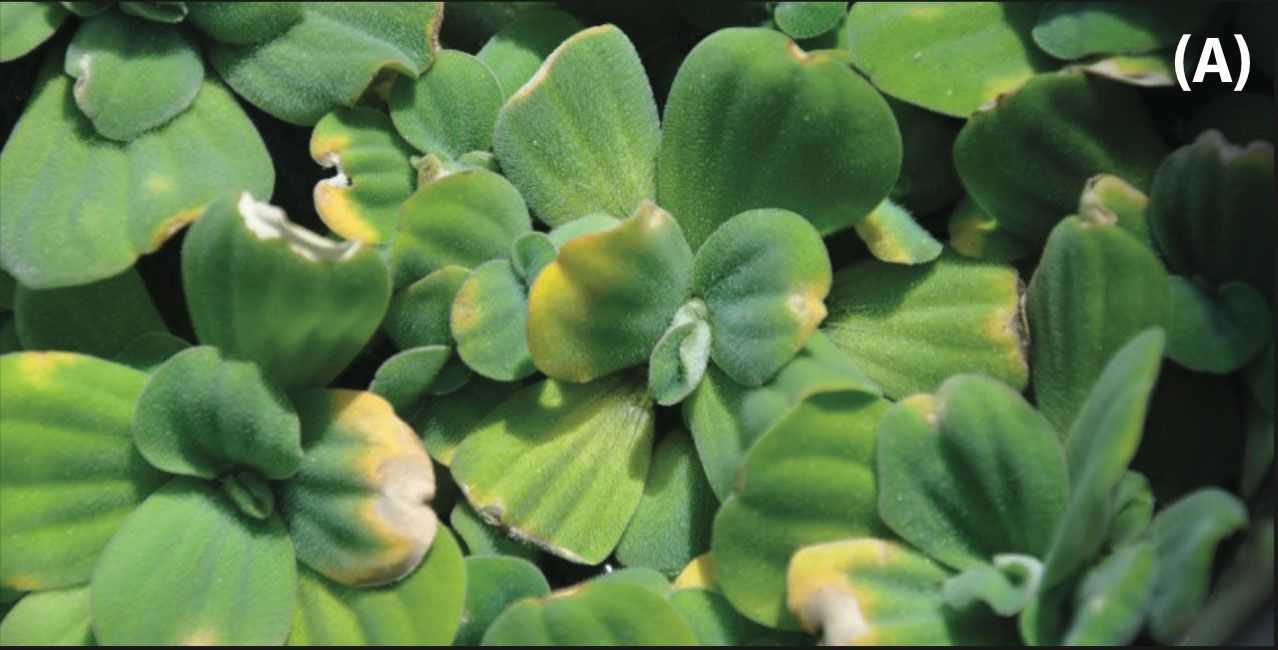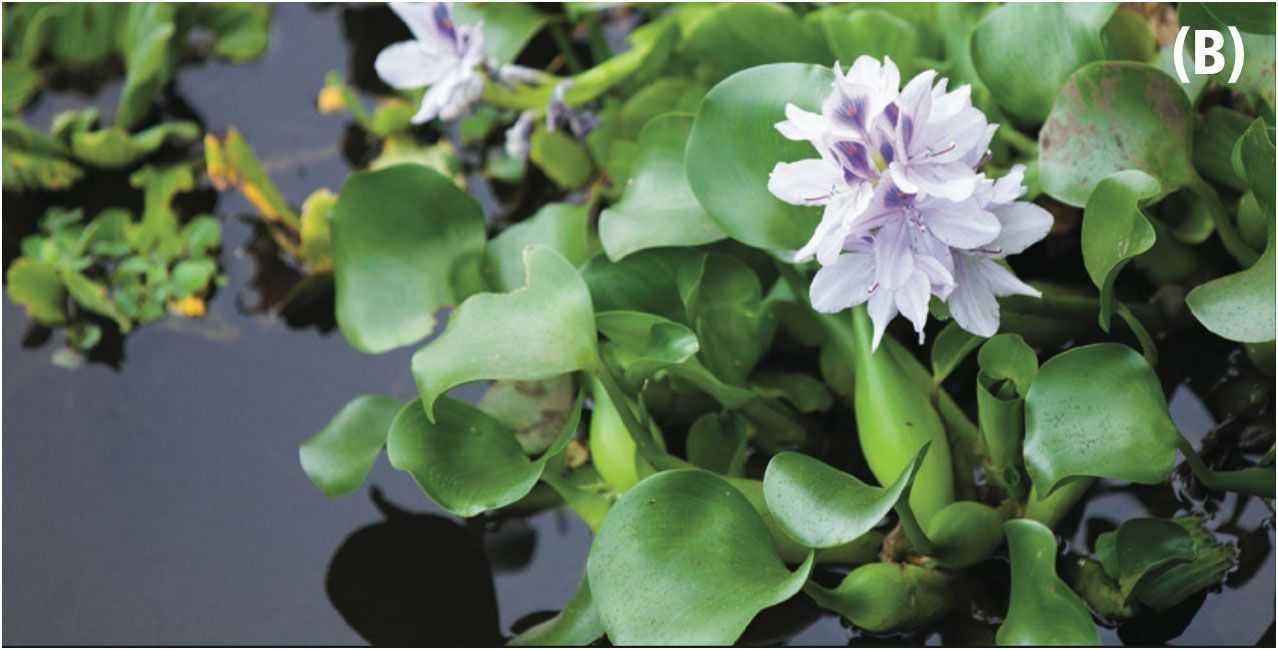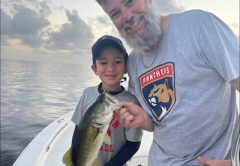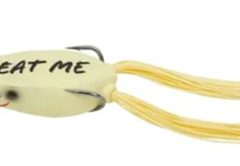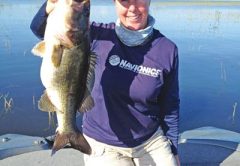The last of the four zones of aquatic plants in our series is the free-floating zone. These are the aquatic wanders of Lake Okeechobee. Plants in this zone have no roots to the lake’s bottom and they move about the lake via wind and current. This also makes them very frustrating to fish for one day they may be holding bass and the next day there isn’t a bass to be found.
LOCAL AQUATIC PLANTS INCLUDE:
(A) WATER LETTUCE, (B) WATER HYACINTH, (C)PENNYWORT, AND (D) DUCK WEED. WHEN FOUND IN SMALL COLONIES THEY CAUSE NO HARM.
Local varieties include; Water Lettuce, Water Hyacinth, Pennywort, and Duck Weed. When found in small colonies they cause no harm. When allowed to grow unrestricted they will cover vast areas of surface and block sunlight from entering the water column. For species like Water Hyacinth and Water Lettuce, once they form large mats, when driven to shore by wind or current, the sheer weight of the mats can crush and destroy any beneficial shoreline vegetation. Also when allowed to grow into large mats these plants can become a hazard to navigation and water flow. For these reasons many of these plants are considered invasive and are targeted by the State’s eradication programs.
In Lake Okeechobee, our infamous mats usually consist of Water Hyacinth. These plants are native to South America and were introduced into the United States back in 1884 during the World’s industrial and Cotton Centennial Exposition in New Orleans. They are considered one of the fastest growing plants in the world and a mat can double in size within two to three weeks. The mat can become so dense that a single acre of mat can weigh more than 200 tons.
During south Florida’s fall and winter months there is a general die off of Water Hyacinth and
the mats will shrink in size and open up clear pockets which make them easier to fish. During this period and depending on the size and density of the mat, light punch baits, weedless soft plastics and spinnerbaits can all be used. Come spring time spawning females will move in and nest in the new growth areas. During this period you’ll want to pay attention to the deeper channels for the females will use these to get in and out of the mats.
Once the waters warm up, the growth rate of water Hyacinth rapidly increases and the mats begin to thicken and by summer become almost impenetrable to even the heaviest of punching baits. During this period, fishing along the edges and pockets open to deeper water are about the only opportunity you may have. Crank baits, weedless plastics, and weedless frogs are the best choices of bait under these conditions. Since the mats are floating and on the move, bottom structure becomes critical as to whether the mat is holding fish. Mats over deeper water are better than mats over shallow water. If a mat is showing signs of decay or if a mat’s movement has become stagnant, the underlying oxygen level may be on the decline and the fish may have moved on to better conditions.
Water Lettuce is another invasive free-floating plant from South America and was most likely introduced to south Florida in the mid 1760’s as a by-product of early trade and shipping. Similar in impact to Water Hyacinth, in small to moderate formations, it provides good cover and fishing opportunities. When in large amounts they become destructive to the environment and impeded navigation and flood control. Fishing Water Lettuce is similar to fishing Water Hyacinth, weedless soft plastics, spinner baits, and mat punching baits during the good times and crank baits, spinner baits, and weedless frogs along the perimeter edges when the mat gets too thick.
Pennywort is a relatively small leafed plant usually found growing along the shoreline and reaching out into deeper water. Its small leaves are round half-dollar shaped and seldom reach out more than 10-inches in height. What makes this floating plant difficult to fish is that the plant consists of long creeping vines that become intertwined with each other making pulling out a nice bass extremely challenging. More often than not you’ll find yourself entering a thick Pennywort mat to retrieve your fish or your bait. The thing is, along rivers and quickly falling shorelines these mats become a bass magnet. They provide bass with excellent cover, foraging, and quick access to deep water. If you’re on the Kissimmee River or the Caloosahatchee River they are a must stop and fish spot. The best method, and probably the only method, to fish the inside of a thick mat is to punch it with stout tackle. The issue isn’t getting past the surface of the mat; the issue is getting your lure or fish out of it. If you’re not going to punch it then fishing the outside edge is your next best bet. If the water is deep enough you can use a crank bait or spinner bait and work parallel to the weed line. I know trolling is not something bass fishermen generally admit to but I frequently troll or drift past a mat of Pennywort with my rod tip in the water angled under the mat and I’ve surprised quite a few bass this way.
Duckweed is a very small light green free-floating plant found in quiet shallow backwaters and offshoot canals and trails. Often it is referred to as ‘pond scum’ and can resemble tiny clover floating in the water. In large colonies it forms dense mats that can block out sunlight which can have a negative impact of the water’s oxygen content. On the plus side, since the individual plants are so small they can be fished with just about any type of presentation. Dragging a floating frog through the scum creates a nice silhouette and disturbance which can produce explosive strikes. Crankbaits, spinnerbaits, and soft plastics all can be used in this environment since these tiny floating plants put up no resistance. The key to success in fishing Duckweed is analyzing the underlying structure of the water. Since Duckweed is found in shallow quiet areas, there needs to be some key feature holding a bass there. Is it close to a deeper channel, are there some sunken logs there, is a culvert or runoff stream nearby, is it a part of a larger vegetation change, look for these signs and you’ll improve your success rate.
Through-out this entire series, from emergent plants, to floating leafed plants, to submergent plants, to free-floating plants, a general theme has emerged. Bass gravitate towards change. Whether it’s a change in oxygen levels, a change in temperature, a change in cover, or a change in the lake’s underwater structure, bass utilize changing conditions to give themselves an advantage over their prey. In south Florida’s lakes and rivers, aquatic vegetation is a critical component of the ever changing aquatic environment. To successfully master bass fishing in Lake Okeechobee and the surrounding lakes and rivers is to understand the symbiotic relationship between the fish and the local aquatic plant population.
We hope this series provided you with some insight into the interaction between the bass and our local aquatic plants and have helped you become a more successful fisherman.

